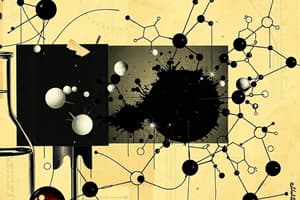Podcast
Questions and Answers
Q2. Which ionic compound shows both frenkel and schottky defects?
Q2. Which ionic compound shows both frenkel and schottky defects?
AgBr shows both frenkel and schottky defects.
Q1. What are the five types of chemistry?
Q1. What are the five types of chemistry?
Inorganic chemistry, organic chemistry, physical chemistry, analytical chemistry, and biochemistry.
Q3. What is produced when we pass chlorine into slaked lime?
Q3. What is produced when we pass chlorine into slaked lime?
Bleaching Powder is produced when we pass chlorine into slaked lime.
Q4. What is the study of chemistry?
Q4. What is the study of chemistry?
Q5. How many types of defects does AgBr show?
Q5. How many types of defects does AgBr show?
What is the Gattermann reaction?
What is the Gattermann reaction?
Who is the chemist after whom the Gattermann reaction is named?
Who is the chemist after whom the Gattermann reaction is named?
What is the Gattermann–Koch reaction?
What is the Gattermann–Koch reaction?
What is used in place of hydrogen cyanide in the Gattermann reaction to simplify the process?
What is used in place of hydrogen cyanide in the Gattermann reaction to simplify the process?
Why is Zn(CN)2 considered safer to work with than gaseous HCN in the Gattermann reaction?
Why is Zn(CN)2 considered safer to work with than gaseous HCN in the Gattermann reaction?
Flashcards are hidden until you start studying


